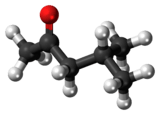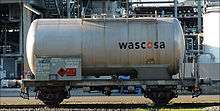Methyl isobutyl ketone
 | |
 | |
| Names | |
|---|---|
| IUPAC name
4-Methyl-2-pentanone | |
| Other names
Isopropylacetone, Hexone, Isobutyl methyl ketone, 4-Methylpentan-2-one, 4-methyl-2-pentanone, 2-methyl-4-pentanone, 2-methylpropyl methyl ketone, 4-methyl-2-oxopentane, MIK, isobutylmethyl ketone, MIBK, isohexanone | |
| Identifiers | |
| 108-10-1 | |
| ChemSpider | 7621 |
| EC Number | 203-550-1 |
| Jmol interactive 3D | Image |
| KEGG | C19263 |
| PubChem | 7909 |
| RTECS number | SA9275000 |
| |
| |
| Properties | |
| C6H12O | |
| Molar mass | 100.16 g/mol |
| Appearance | colorless liquid |
| Odor | pleasant[1] |
| Density | 0.802 g/mL, liquid |
| Melting point | −84.7 °C (−120.5 °F; 188.5 K) |
| Boiling point | 117 to 118 °C (243 to 244 °F; 390 to 391 K) |
| 1.91 g/100 mL (20 °C) | |
| Vapor pressure | 16 mmHg (20 °C)[1] |
| Refractive index (nD) |
1.3958 |
| Viscosity | 0.58 cP at 20.0 °C |
| Structure | |
| 2.8 D | |
| Hazards | |
| EU classification (DSD) |
Flammable (F) Harmful (Xn) |
| R-phrases | R11, R20, R36/37, R66 |
| S-phrases | (S2), S9, S16, S29 |
| NFPA 704 | |
| Flash point | 14 °C (57 °F; 287 K) |
| 449 °C (840 °F; 722 K) | |
| Explosive limits | 1.2%-8.0% (93 °C)[1] |
| US health exposure limits (NIOSH): | |
| PEL (Permissible) |
TWA 100 ppm (410 mg/m3)[1] |
| REL (Recommended) |
TWA 50 ppm (205 mg/m3) ST 75 ppm (300 mg/m3)[1] |
| IDLH (Immediate danger |
500 ppm[1] |
| Related compounds | |
| Related ketones |
Methyl isopropyl ketone 2-Pentanone Diisobutyl ketone |
| Related compounds |
2-Methylpentan-4-ol |
| Except where otherwise noted, data are given for materials in their standard state (at 25 °C [77 °F], 100 kPa). | |
| | |
| Infobox references | |
Methyl isobutyl ketone (MIBK) is the organic compound with the formula (CH3)2CHCH2C(O)CH3. This colourless liquid, a ketone, is used as a solvent for gums, resins, paints, varnishes, lacquers, and nitrocellulose.[2]
Production
Methyl isobutyl ketone is manufactured from acetone via a three-step process. Firstly acetone undergoes an aldol condensation to give diacetone alcohol, which readily dehydrates to give mesityl oxide. Mesityl oxide can then be hydrogenated to give MIBK:
Industrially, these three steps are combined. Acetone is treated with a strong acidic, palladium-doped cation exchange resin under medium pressure of hydrogen.[3] Several million kilograms are produced annually.[4] In 2003, the industrial production capacity for MIBK in the United States was 88,000 tons.[5]
Uses

MIBK is used as a solvent for nitrocellulose, lacquers, and certain polymers and resins.[4]
Precursor to 6PPD
Another major use is as a precursor to N-(1,3-dimethylbutyl)-N'-phenyl-p-phenylene diamine (6PPD), an antiozonant used in tires. 6PPD is prepared by reductive coupling of MIBK with 4-aminodiphenylamine.[6]
Solvent and niche applications
Unlike the other common ketone solvents, acetone and MEK, MIBK has quite low solubility in water, making it useful for liquid-liquid extraction. It has a similar polarity to ethyl acetate, but greater stability towards aqueous acid and base. It can be used to extract gold, silver and other precious metals from cyanide solutions, such as those found at gold mines, to determine the levels of those dissolved metals. Diisobutyl ketone (DIBK), a related lipophilic ketone, is also used for this purpose. Methyl isobutyl ketone is also used as a denaturing agent for denatured alcohol. When mixed with water or isopropyl alcohol MIBK serves as a developer for PMMA electron beam lithography resist. MIBK is used as a solvent for CS in the preparation of the CS spray used currently by British police forces.[7]
References
- 1 2 3 4 5 6 "NIOSH Pocket Guide to Chemical Hazards #0326". National Institute for Occupational Safety and Health (NIOSH).
- ↑ US EPA. "Methyl Isobutyl Ketone (Hexone)". Retrieved 13 December 2015.
- ↑ , Uhde Technology Profile: MIBK
- 1 2 Stylianos Sifniades, Alan B. Levy, "Acetone" in Ullmann’s Encyclopedia of Industrial Chemistry, Wiley-VCH, Weinheim, 2005.
- ↑ International Agency for Research on Cancer. "Methyl Isobutyl Ketone" (PDF). Retrieved 13 December 2015.
- ↑ Hans-Wilhelm Engels et al., "Rubber, 4. Chemicals and Additives" in Ullmann's Encyclopedia of Industrial Chemistry, 2007, Wiley-VCH, Weinheim. doi:10.1002/14356007.a23_365.pub2
- ↑ Peter J Gray; Stark, MM; Gray, P. J; Jones, G R. N (2000). "Is CS spray dangerous? : CS is a particulate spray, not a gas" (Response to editorial). BMJ 321 (7252): 26. doi:10.1136/bmj.321.7252.46. PMC 1127688. PMID 10939811.
External links
- International Chemical Safety Card 0511
- National Pollutant Inventory - Methyl isobutyl ketone fact sheet
- NIOSH Pocket Guide to Chemical Hazards
|

